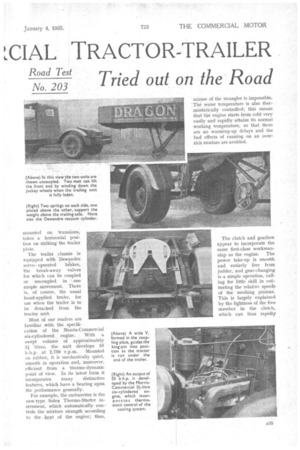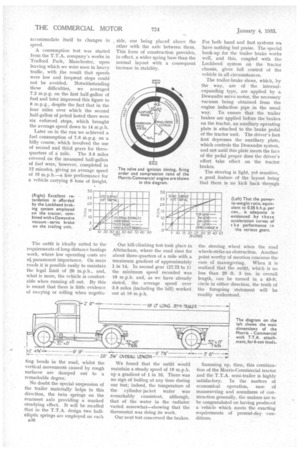THE NEW MORRIS-COMMI
Page 44

Page 45

Page 46

If you've noticed an error in this article please click here to report it so we can fix it.
;CIAL TRACTOR-TRAILER No. 203 Tried out on the Road
A 6-ton Outfit Incorporating a T.T.A. Semi-trailer Proves Itself an Efficient Mach e with Good Accelerative and Braking Characteristics and Excellent Manceuvrability
UNLESS there be a great alteration in the framework of the regulations governing the roadtransport industry, the articulated six-wheeled vehicle will soon become even more popular than it is at the moment. Doubtless the directorate of Morris Commercial Cars, Ltd., realized the potentialities of this form of transport when the tractor chassis was introduced some little time ago. With this type of outfit a relatively light tractor unit can be employed, which, when manufactured on quantity-production lines, is low priced, whilst a semi-trailer, also built in quantities, can be produced quite cheaply.
In the case under review the Morris-Commercial chassis with a six-cylindered engine costs £265, whilst with a semi-trailer, manufactured by the Truck and Tractor Appliance Co. (M/ cr.), Ltd., the complete outfit is moderately priced at £450, this figure including many extras to the standard
specification. It is possible to produce a non-detachable trailer which is sufficiently light to bring the total weight of the outfit within the 3-ton limit, so that a tax of only £35 will be payable.
The particular vehicle tested comprised a standard Morris-Commercial chassis with a detachable 6-ton trailer unit, the latter having a steel frame and patent axle suspension. Fully laden, with an evenly distributed freight, it was possible for two moderately powerful men to wind down the front supporting wheels and take the load off the tractor unit. Furthermore, when the tractor was unhitched the trailer could be manhandled by means of a tiller bar without excessive effort.
As will be realized from one of *lie accompanying illustrations, the coupling is entirely automatic in action, and as the top portion of the hitch has a wide entrance it will engage the king-pin from almost any angle. Variations in ground level are compensated for by the hang of the uncoupled hitch; this plate, which is mounted on trunnions, takes a horizontal position on striking the trailer plate.
The trailer chassis is equipped with Dewandre servo operated brakes, the break-away valves for which can be coupled or uncoupled in one simple movement. There is, of course, the usual hand-applied brake, for use when the trailer is to be detached from the tractor unit.
Most of our readers are familiar with the specification of the Morris-Commercial six-cylindered engine. With a swept volume of approximately 3i litres, the unit develops 55 b.h.p. at 2,750 r.p.m. Mounted on rubber, it is mechanically quiet, smooth in operation and, moreover, efficient from a thermo-dynamic point of view. In its latest form it incorporates many distinctive features, which have a bearing upon the performance generally.
For example, the carburetter is the new-type Solex Thermo-Starter instrument, which automatically controls the mixture strength according to the heat of the engine; thus, misuse of the strangler is impossible. The water temperature is also thermostatically controlled; this means that the engine starts from cold very easily and rapidly attains its normal working temperature, so that there are no warming-up delays and the bad effects of running on an overrich mixture are avoided.
The clutch and gearbox appear to incorporate the same first-class workmanship as the engine. The power take-up is smooth and entirely free from judder, and gear-changing is a simple operation, calling for little skill in estimating the relative speeds of the meshing pinion. This is largely explained by the lightness of the free member in the clutch, which can thus rapidly accommodate itself to changes in speed.
A consumption test was started from the T.T.A. company's works in Trafford Park, Manchester, upon leaving which we were soon in heavy traffic, with the result that speeds were low and frequent stops could not be avoided. Notwithstanding these difficulties, we averaged 7.2 m.p.g. on the first half-gallon of fuel and later improved this figure to 8 m.p.g., despite the fact that in the four miles over which the second half-gallon of petrol lasted there were six enforced stops, which brought the average speed down to 14 m.p.h.
Later on in the run we achieved a fuel consumption of 7.6 m.p.g. on a hilly course, which involved the use of second and third gears for threequarters of a mile. The 3.8 miles covered on the measured half-gallon of fuel were, however, completed in 12 minutes, giving an average speed of 19 m.p.h.—a tine performance for a vehicle carrying 6 tons of freight.
The outfit is ideally suited to the requirements of long-distance haulage work, where low operating costs are of, paramount importance. On main roads it is possible easily to maintain the legal limit of 20 m.p.h., and, what is more, the vehicle is comfortable when running all out. By this is meant that there is little evidence of swaying or rolling when negotia ting bends in the road, whilst the vertical movements caused by rough surfaces are damped out to a remarkable degree.
No doubt the special suspension of the trailer materially helps in this direction, the twin springs on the rearmost axle providing a marked steadying effect. It will be recalled that in the T.T.A. design two halfelliptic springs are employed on each B36 side, one being placed above the other with the axle between them. This form of construction provides, in effect, a wider spring base than the normal layout with a consequent increase in stability.
Our hill-climbing test took place in Altrincham, where the road rises for about three-quarters of a mile with a maximum gradient of approximately 1 in 14. In second gear (27.73 to 1) the minimum speed recorded was 10 m.p.h. and, as we have already stated, the average speed over 3.8 miles (including the hill) worked out at 19 m.p.h.
We found that the outfit would maintain a steady speed of 10 m.p.h. up a gradient of 1 in 16. There was no sign of boiling at any time during our test; indeed, the temperature of the cylinder-jacket water was remarkably consistent, although, that of the water in the radiator varied somewhat—showing that the thermostat was doing its work, Our next test concerned the brakes. For both hand and foot systems we 'have nothing but praise. The special hook-up for the trailer brake works well, and this, coupled with the Lockheed system on the tractor chassis, gives full control of the vehicle in all circumstances.
The trailer-brake shoes, which, by the way, are of the internalexpanding type, are applied by a Dewandre servo motor, the necessary vacuum being obtained from the engine induction pipe in the usual way. To ensure that the trailer brakes are applied before the brakes on the tractor, an auxiliary operating plate is attached to the brake pedal of the tractor unit. The driver's foot first depresses the auxiliary plate, which controls the Dewandre system, and not until this plate meets the face of the pedal proper does the driver's effort take effect on the tractor brakes.
The steering is light, yet sensitive, a good feature of the layout being that there is no kick back through the steering wheel when the road wheels strike an obstruction. Another point worthy of mention conderns the ease of mancepyring. When it is realized that the outfit, which is no less than 29 ft. 3 ins, in overall length, can be turned in a 43-ft. circle in either direction, the truth of the foregoing statement will be readily understood.
Summing up, then; this combination of the Morris-Commercial tractor and the T.T.A. semi-trailer is highly satisfactory. In the matters of economical operation, ease of manoeuvring and soundness of construction generally, the makers are to be congratulated on having produced a vehicle which meets the exacting requirements of present-day conditions.




















































































